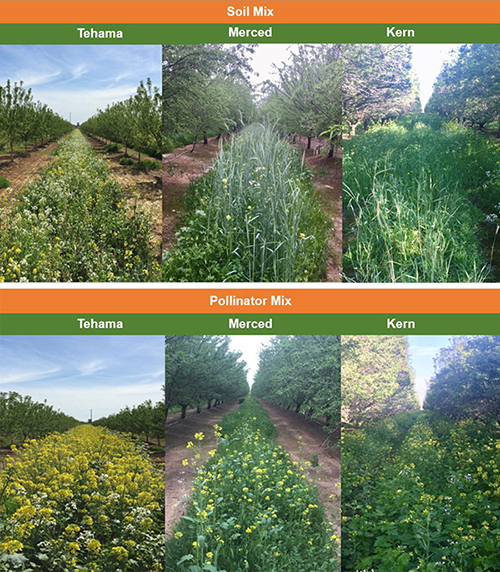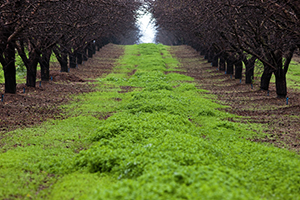(Feb. 21, 2020) – Research funded by the Almond Board of California (ABC) continues to show that planting winter cover crops between orchard rows is good for the soil, good for water infiltration, and, depending on the type and development of the cover crop planted, good for honey bees.
Still, however, remains the largest hurdle to widespread adoption of planting cover crops: growers’ skepticism that the benefits of cover crop growth outweigh the work of fitting a cover crop into their almond growing system.
That’s one of the key takeaways that UC Davis’ Department of Plant Science faulty member Amelie Gaudin shared during her presentation at The Almond Conference 2019 last December. Gaudin, who has spent the past three years leading an ABC-funded research project studying whether or not cover crops make sense for the almond industry, noted that "there appears to be doubt and confusion around how cover cropping can be implemented and incorporated into one’s operation."
“There is this perceived idea that you’re going to have plants and residues on the orchard floor at harvest," said Gaudin, "but that's easily avoidable if you terminate the cover crops promptly post-bloom, keeping cover crops as a winter practice."
 Cover Cropping Backed by Science
Cover Cropping Backed by Science
When asked by growers if cover crops have true benefits to their orchards, Gaudin is quick to say “yes” – and the team now has the science to prove it.
At orchard testing sites in Tehama, Merced and Kern counties, Gaudin and collaborators have carefully tracked what happens when growers either let native vegetation grow or plant cover crops, then rely on winter rains for water supply, allow the crops grow and bloom, and remove them in the spring via herbicides and/or mowing.
The team studied two seed mixes at these sites – one directed primarily at improving soil conditions, and the other weighted toward helping honey bees. Both achieve multiple purposes, however.
The “soil mix” is composed of 10% Bracco white mustard, 10% Daikon radish, 30% Merced ryegrain, 20% Berseem clover and 30% common vetch. The “pollinator mix” is composed of 15% Bracco white mustard, 20% Daikon radish, 15% Nemfix yellow mustard, 15% common yellow mustard and 35% canola.
Research shows that a mixture higher in legumes (such as clover and vetch) can boost nitrogen levels in the soil; conversely, grasses can help reduce nitrogen losses, decreasing compaction and improving infiltration.
As noted in ABC’s Honey Bee Best Management Practices, cover crops and the nutrients they provide can be an excellent supplement to almond pollen and nectar for overall bee health, making for more robust hives. Gaudin said it is still unknown, however, whether cover crops compete with blossoms for bee visitation during bloom - this is one of the questions research teams are addressing this bloom season. Previous study results suggest that plantings adjacent to orchards (rather than between orchards rows) do not compete with blossoms for pollinator attention. Currently, there is not a general consensus regarding plantings between orchard rows but, if there is competition taking place, it is likely very low.
Beyond contributions to soil and pollinator health, the team found that cover crops, depending on the mix, are also capable of:
- effectively improving water infiltration and addressing aggregation and compaction issues, which plagued some of the trial locations,
- relying on winter rains and therefore not increasing overall irrigation water demand,
- significantly decreasing winter weed pressure and diversity, and
- increasing microbial biomass and shifting biological properties in the soil, which includes increasing populations of beneficial bacterial-feeding nematodes.
 Another concern commonly raised by growers is how to maintain a cover crop when flail mowing mummy nuts during winter sanitation is necessary. (Mummy nuts, or the nuts left on the trees after harvest, harbor overwintering Navel Orangeworm larvae. Under dry conditions, when mummies are knocked to the ground during winter sanitation, flail mowing is recommended to ensure the nuts are destroyed before the moths can emerge.) Dr. Houston Wilson's research team is currently investigating interactions between sanitation and cover crops, and whether mummies falling into cover crops experience different breakdown due to higher moisture conditions and predation.
Another concern commonly raised by growers is how to maintain a cover crop when flail mowing mummy nuts during winter sanitation is necessary. (Mummy nuts, or the nuts left on the trees after harvest, harbor overwintering Navel Orangeworm larvae. Under dry conditions, when mummies are knocked to the ground during winter sanitation, flail mowing is recommended to ensure the nuts are destroyed before the moths can emerge.) Dr. Houston Wilson's research team is currently investigating interactions between sanitation and cover crops, and whether mummies falling into cover crops experience different breakdown due to higher moisture conditions and predation.
The Key to Cover Cropping
Gaudin said the key for effective cover cropping is for growers to first assess what goal(s) they want to achieve by employing a cover crop. For example, are they looking to improve water infiltration, or is their main aim to provide pollination habitat? She suggested a grower will likely need to try different mixes when looking to reach their goal, depending upon the outcome they want to achieve in their orchard and what works well on a specific piece of land.
The Seeds for Bees program, operated by Project Apis m. (PAm), looks to support growers interested in planting cover crops by only offering a slew of information on cover crop management but also – mainly – providing growers with seed mixes focused on providing pollinator habitat at little-to-no cost. (Check out PAm’s Forage Resource Guide to Seed Mixes for more information.) Kat Jarvis-Shean, orchard crop advisor for Solano and Yolo counties, also created a useful guide that covers what growers should consider when preparing to plant cover crops and what mixes are more likely to achieve certain goals.
Persistent Perceptions Still Exist
Part of Gaudin’s research includes a short online survey asking growers if they practice cover cropping, and why or why not. Of the 114 people who have responded, only about half say they have experimented with cover crops, and of that group, about 20% say they tried it once and stopped.
“Some say it’s too complex to manage effectively. Others say they’re not sure they’re getting the benefits they wanted,” Gaudin said. “Some are worried about operational constraints, or are just uncertain about what to plant.”
Gaudin said that to manage cover crops growers should think about them as just another crop they’re look to grow: Once they’ve finished blooming or their presence is getting in the way of other operations in the spring, they should be treated with a herbicide and/or mowed down. By summer and certainly well before harvest, the orchard floor will be clean and smooth.
Growers looking for further guidance and advice on cover crop management are welcome to contact Gaudin at agaudin@ucdavis.edu or ask their local farm adviser for assistance.